Class 4 Science Chapter 6 Question Answers - Reproduction in Animals
Q1: Why frog lays egg coverless, whereas, Hen lays it with hard cover? Explain.
 View Answer
View Answer 
Ans: Hen reproduces through internal fertilization in which the egg is already fertilized before coming out as in form of egg.In the case of frog there is external fertilization, hence, egg fertilizes outside the female body. Female lays coverless eggs in the water body later male deposit there sperm over them. And with the help of tail, the sperm swims and fuses with egg. If these eggs have hard covering then it is impossible for the sperm to fuse with them and thus the reproduction cannot be possible.
Q2: Explain the importance of reproduction in organisms.
 View Answer
View Answer 
Ans: Reproduction is a process which is essential to maintain the life of an individual.
The organisms reproduce because of the two main reasons: -
- To continue one's progeny
- It provides group immortality by replacing the dead individuals with the new ones for the survival of the species on this earth.
Q3: Explain cloning with an example of first cloned animal.
 View Answer
View Answer 
Ans: Cloning is defined as the production of exact copy of a cell, any other living part or a complete organism. Cloning of an animal was first of all performed successfully by Lan Wilmut and his colleagues, for the first time a sheep named as dolly was cloned successfully; Dolly was born on 5 July 1996 and was the first mammal to be cloned. The process of cloning involve collection of cell from the mammary gland of a female Finn Dorsett sheep and an egg whose nucleus was removed was obtained from a Scottish blackface ewe then nucleus from the mammary gland of Finn Dorsett sheep was inserted into egg of Scottish blackface ewe, the egg thus produced was implanted into the Scottish blackface ewe, development of this egg take place normally and finally Dolly was produced.
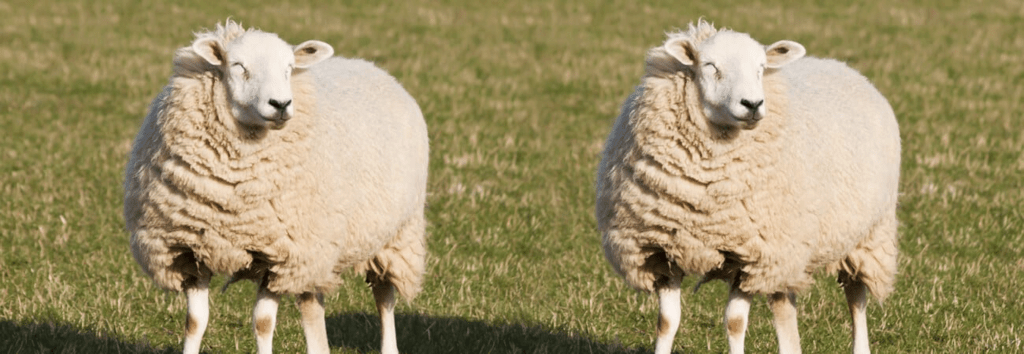
Q4: What do you mean by reproduction? Explain various modes of reproduction.
 View Answer
View Answer 
Ans: The process of producing young ones of the same species is known as reproduction. It is very important process. It helps in the continuation of a species on the earth.
Modes of Reproduction: There are following modes of reproduction:
(i) Sexual reproduction
(ii) Asexual reproduction.
(i) Sexual reproduction: The process of reproduction in which two parents (male and female) are involved is called sexual reproduction. In this process male produces male gametes and female produces female gametes. Both the gametes are fused to form zygote. The zygote develops into baby. Example: cow, cat, dog and human beings.
(ii) Asexual reproduction: The mode of reproduction in which only one parent is involved to produce new young ones is called asexual reproduction. Budding, fragmentation spore formation and binary fission are the methods of asexual reproduction like in hydra, amoeba and bacteria etc.
Q5: What is fertilisation? Explain various types of fertilisation.
 View Answer
View Answer 
Ans: When sperms come in contact of an egg, one of the sperms may fuse with the egg. Such type of fusion of sperm and egg is called fertilisation. In this process formation of zygote takes place. There are following two types of fertilisation:
(i) Internal fertilisation
(ii) External fertilisation.
(i) Internal fertilisation: The fertilisation in which fusion of egg and sperm takes place inside the body of female is called internal fertilisation. Internal fertilisation takes place in many animals like, cow, dogs, hens and human beings.
(ii) External fertilisation: The fertilisation in which fusion of egg and sperm takes place outside the body of female is called external fertilisation. It is very common in aquatic animals like fish, frog and starfish etc.

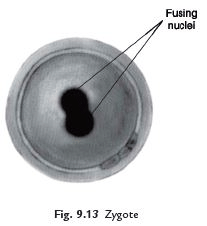
Q6: Explain the fertilisation in frog.
 View Answer
View Answer 
Ans: In frogs external fertilisation takes place. During rainy season frogs move to ponds and slow-flowing streams. When the male and female frog come together in water, the female lays hundreds of eggs. The eggs of frog are not covered by a shell and they are comparatively very delicate. A layer of jelly holds the eggs together and provides protection to the eggs. As the eggs are laid, the male deposits sperms over them. Each sperm swims randomly in water with the help of its tail. The sperms come in contact with eggs and fuse together. This results in fertilisation
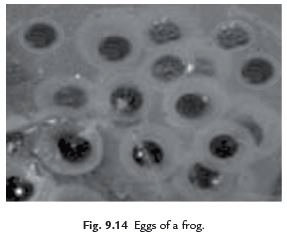
Q7: Explain the development of embryo.
 View Answer
View Answer 
Ans: Fertilisation results in the formation of zygote which begins to develop into an embryo. The zygote divides repeatedly to give rise to a ball of cells. The cells then begin to form groups that develop into different tissues and organs of the body. This developing structure is termed as embryo. This embryo gets embedded in the wall of the uterus for further development. The embryo continues to develop in the uterus. It gradually develops body parts such as hands, legs, head, eyes and ears etc. This stage is called foetus. Mother gives birth to the baby when foetus developed completely.
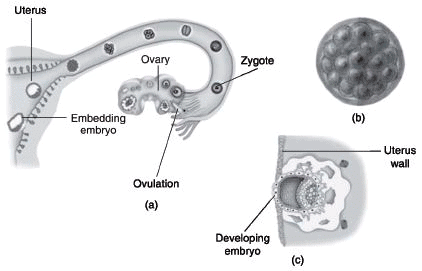
Fig. 9.15 (a) Zygote formation and development of an embryo from the zygote; (b) Ball of cells (enlarged); (c) Embedding of the embryo in the uterus (enlarged).
Q8: Explain the formation of clone Dolly.
 View Answer
View Answer 
Ans: Cloning is the production of an exact copy of a cell, a part or complete body. Dolly was the first clone born on 5th July 1996 and was the first mammal to be cloned. It is cloned by Ian Wilmut and his colleagues. During the process of cloning Dolly, a cell was collected from the mammary gland of female Finn Dorsett sheep.
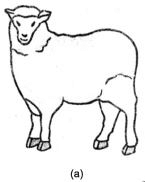

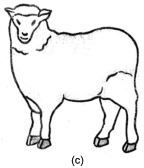
Fig. 9.16 (a) Finn Dorsett sheep (b) Scottish blackface ewe (c) Dolly (July 1996 to Feb. 2003).
Simultaneously, an egg was obtained from a Scottish blackface ewe. The nucleus was removed from the egg, then the nucleus of mammary gland cell from the Finn Dorsett sheep was inserted into egg of Scottish blackface ewe. Development of this egg followed normally and finally Dolly was born. It was found to be absolutely identical to the Finn Dorsett sheep and produced several offspring of her own through normal sexual means. Dolly died on 14th February 2003 due to a certain lung disease.
Q9: What are Sexually Transmitted Diseases? How can they be prevented?
 View Answer
View Answer 
Ans: The diseases spread only by sexual contact are called sexually transmitted diseases (STDs). When a healthy person contacts sexually to a person which is infected, then the microorganisms are transmitted from infected person to the healthy person and that becomes infected. Syphilis, gonorrhoea, herpes and AIDS are some sexually transmitted diseases. Herpes and AIDS are not curable diseases. These are fatal diseases, which destroy the immune system of the patient. Sexual hygiene and safe sexual relationship are the only way to prevent sexually transmitted diseases.
|
90 videos|296 docs|44 tests
|
FAQs on Class 4 Science Chapter 6 Question Answers - Reproduction in Animals
| 1. What is reproduction in animals? |  |
| 2. How do animals reproduce? |  |
| 3. What are the different modes of reproduction in animals? |  |
| 4. How do animals ensure successful reproduction? |  |
| 5. What are the challenges faced by animals during reproduction? |  |

















